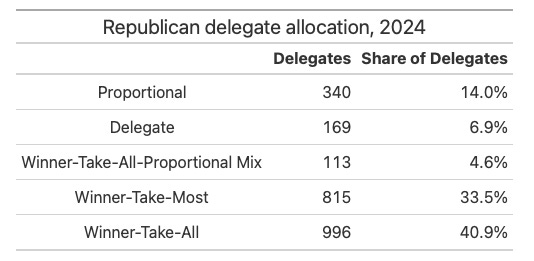Why Trump will probably win the 2024 GOP nomination.
Plus... 13 books that have shaped my thinking. And a new section: Doomier and Loopier.
Hello, and welcome to the 2nd issue of Undercurrent Events.
I did something gimmicky in this issue. I wrote about Trump because everyone wants to read about Trump even though they say they don’t. But I used his 2024 candidacy to talk about rules and institutions and how winner-take-all primary rules give him a distinct advantage.
What you learn may surprise you…
Why Trump will probably win the GOP nomination (again)
Or: How the party’s winner-take-all primary rules foster division, hinder coordination, and boost a factional candidate.
Or: It’s the rules, stupid
Over the next year and a half, you are going to hear lots and lots about the Republican primary. Most will be about the easy-to-follow polling. Fun stuff.
But in this post, I want to take a huge step back and talk about the rules.
Specifically, I want to explain how a series of majoritarian primary contests will elevate zero-sum competition and boost the candidate with the strongest factional support. That is, as of now: Trump.
Trump is weakened for sure. But I’d bet he still has the solid support of 40 percent of GOP primary voters. That is almost certainly enough to win, given how frontloaded the primary is.
The big day in the primary will be March 5, in which 780 delegates (almost a third of all delegates) are in play. California and Texas hold their primaries on March 5. California is winner-take-all. Texas is winner-take-most. Most of the states holding primaries on that day are winner-take-most primaries.
Two weeks later (March 19) Ohio, Florida, Illinois and Arizona all hold winner-take-all primaries, allocating 306 delegates by this method.
Below, I’ve laid out the Republican calendar delegate allocation formulas.
Republicans shifted to more winner-take-all primaries in 2016. Party leaders fretted that too many proportional primaries (a step taken for 2012 to make the primaries less front-loaded) kept the party from settling on a frontrunner early, putting them at a disadvantage — particularly in a year in which Obama was the obvious Democratic nominee.
In 2016, only 391 delegates were allocated in winner-take-all primaries. In 2024, by my calculations, 996 will be allocated by winner-take-all. The share of proportionally-allocated delegates, by contrast, has fallen from 637 to 340.
These totals come from the Green Papers website, which offers more detailed explanations for how these different primaries all work.
At this point you might think the obvious: hasn’t “the Republican establishment” learned its lesson already about Trump? At the very least, don’t they understand that he’s ballot box poison for Republicans? Why can’t they coordinate?
I use the term “Republican establishment” in quotes, because I’m not sure exactly what it means anymore. Or really ever did.
Because there is no real permanent party establishment in either party, Democratic and Republican presidential aspirants build their own machines, separate from the party. In 2016, everyone spoke of the “Clinton Machine.” Before that, it was “Obama world.” The Obama campaign revolutionized the get-out-the-vote effort, not the Democratic Party. Biden has his loyalist network too. All of these are networks of operatives and fundraisers who have built careers around a clique, not a party.
Like other leading figures in the presidential politics world, Trump’s interest has always been building his network, not the party’s. There are factions and cliques within the party’s class of donors and activists.
So, Trump is obviously weakened. And if all the anti-Trump forces could unite around one alternative, that alternative might win. But, here’s the irony (and a consequence of the primary structure): Trump’s weakened position has become his greatest strength. That’s because it attracts a more divided field.
If I’m Nikki Haley or Mike Pompeo or Tim Scott, or any of the names that show up on the potential contenders list, I see the following path: Trump and DeSantis as the frontrunners engage in mutual destruction. An opening emerges, just in time for the March winner-take-most-or-all bonanza.
Ironically, winner-take-all rules encourage candidates to build a narrower winning coalition than they would have to build under more proportional rules. The rules also encourage more divisive in-fighting.
Putting candidates in open competition with each other for delegates in winner-take-all or winner-take-most contests makes coordination especially difficult, because a narrow path to total victory without majority support is real. Trump did it in 2016. The 2024 contest will look very similar.
Certainly, Republicans could go back to a more proportional delegate allocation approach they used in 2012. They could make it harder for any candidate to get a majority of delegates before the convention, and increase the chances of every political junkie’s dream — the “brokered convention.” But nobody wants a divided party.
The institutions and rules of our democracy, particularly around the primary, are both invisible and confusing, so they often get obscured. This is a mistake. So here’s to foregrounding them in our analysis of the coming 2024 campaign.
Biden world to elevate extreme MAGA Republicans
It makes sense tactically. It also makes the doom loop worse.
Politico has a piece out this week on how Biden world has gone from refusing to speak about the most extreme Republicans to shining a spotlight on them.
Tactically, it makes total sense. In a two-party system, heightening the threat of the “other side” is perhaps the easiest way to unify and energize your supporters: If there’s one thing we can all agree on, it’s that we HAVE to win. That means no internal squabbling.
If Biden is gearing up for a second term, this seems an especially excellent strategy.
The “other side is too extreme” also makes a weighty pitch to the remaining moderate-swing-undecided “middle” — or whatever we want to call that small, idiosyncratic and very fuzzy hinge group that keeps deciding elections.
One lesson Democrats could have taken away from the mid-terms was that Republicans paid a penalty for nominating extreme candidates in some key races. Relatedly, Democrats could also even conclude that their controversial efforts to support the more extreme candidates in Republican primaries paid off. They played with fire, but they kept the fire contained. For now.
So yes, of course: Elevate the “other side’s” most stark-raving loopy members to even greater positions of prominence. Shine every klieg light you find onto them. Full blast. Let the people see the true face of the enemy!
Indeed, in a two-party system, in which neither party is particularly popular, the logical strategy is to tear down and disqualify your opponents so you are the only viable alternative.
As a Democrat, I’m not unsympathetic to the tactic. I do think the Republican Party (as defined by its elected officials) is under the sway of an illiberal ideology that denies the legitimacy of its political opposition with dangerous ethno-nationalist tropes and implicit (and sometimes explicit) calls to violence.
But I worry about the consequences of this new Biden strategy. This is Doom Loop logic: Heighten the conflict. Elevate the “conflict entrepreneurs.”
But then what? Extremism only justifies more extremism. Elevating the most extreme elements in the Republican party to even greater prominence only gives them more power and attention. Other Republicans might conclude that the extreme elements should be defended and excused. At least they have the right enemies! This happened with Trump, over and over. There’s a soft line from anti-Trump to anti-anti-Trump to sort-of-pro-Trump.
And yet, if I were advising the Biden administration and focused on winning the next election, it would be hard for me to argue against this tactic.
And this is what it’s like to be stuck in a doom loop: Escalation is always rational in the short-term. And that’s the problem.
What to Read When Your Democracy Is Failing
13 books that have helped shape my thinking on democracy
I wrote up my list for New America’s newsletter, The Thread. You can read it all here.
Here’s my little teaser: American democracy is in crisis. But what, exactly, is the crisis? How should we think about it? And what should we do about it? I’ve read many books over the years to try to understand just these questions. So I compiled 13 books that I think can help us to understand this political moment better, and how we might get to the other side of it. At least, they’ve all helped me understand our political moment better. Each has influenced my thinking in an important way.
That’s all for now. If you like what you’re reading, please share with a friend.
If you got this forwarded to you and you want to subscribe, just click the button below.









